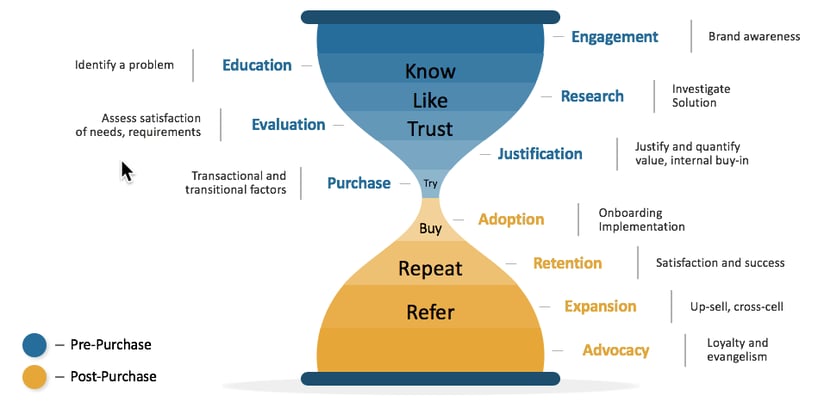Navigating Customer Journey: Strategies for Digital Marketing Success
The term 'Consumer Behavior Theory' has been around for over 120 years, focusing on understanding the customer's buying journey from a supplier-oriented perspective.
The initial theory that analyzed the customer's buying journey was AIDA (Aware-Interest-Desire-Action). With the emergence of advertising concepts, it evolved into AIDMA (Aware-Interest-Desire-Memory-Action) in the 1920s. AIDA/AIDMA provided a consistent definition of the customer's buying journey for about 80 years until the late 90s/early 2000s when online business began to thrive.
Customer Journey Map vs. Consumer Behavior Theory
The rise of online marketing demanded a shift towards a framework for understanding customer behavior, known as AISAS (Attention-Interest-Search-Action-Share).
In the late 2000s, Derek Rucker of the Kellogg School of Management introduced the 4A model: Awareness, Attitude, Act, Act again, simplifying the focus on interest and desire while emphasizing brand loyalty management.
Since then, various attempts have been made to logically understand the customer's buying journey.
Most recently, marketing guru Philip Kotler presented the 5A framework in his book 'Marketing 4.0', highlighting Awareness, Appeal, Ask, Act, Advocate. This model reflects the societal consumption trends of the hyper-connected era, emphasizing the influence of one's immediate community on developing primary affinity towards a brand, followed by external influences until the point of action.
Customer Journey Impact Across Stages
It's clear that marketers need to consider the entire customer buying journey, extending well beyond the point of purchase, as rapid advancements in IT and media lead to unpredictable changes in customer touchpoints.
The importance of having the right content and channels as key elements of the marketing mix at customer touchpoints is increasingly crucial. It's now essential for marketers to understand the significance and execute timely actions effectively.
To effectively deploy digital marketing, segmenting the customer's buying journey into distinct stages, as seen in the Marketing Hourglass, is crucial.

<Marketing Hourglass, ducttape marketing>
For marketers looking to expand their marketing efforts throughout the entire customer buying journey, I highly recommend utilizing the Marketing Hourglass.
This framework ensures that customers are engaged with positive and consistent messaging at various touchpoints, ultimately leading to a seamless end-to-end customer experience.
The table below illustrates the relationship between Philip Kotler's 5A framework and the Marketing Hourglass.
| Framework | 5A | Marketing Hourglass |
| Pre-purchase | Aware | Know |
| Appeal | Like | |
| Ask | Trust | |
| Try | ||
| On-purchase | Act | Buy |
| Repeat | ||
| Post-purchase | Advocate | Refer |
Marketing Hourglass
The 'Marketing Hourglass' serves as a methodology to guide marketers in understanding the overall customer experience throughout the customer buying journey map development.
Comprising the following stages, the Marketing Hourglass provides insights into how customers interact with your business and brand:
1. Know
This stage focuses on how people initially become aware of your business and brand. It involves how content is searched, advertised, and recommended.
- Website - What do you offer when potential customers visit your business website?
- Advertising - How is your business introduced to someone for the first time?
- Marketing materials - Resources that help tell the brand story in a compelling manner.
- Networking - How and where does the brand connect and engage with others?
- Social networks - The depth of engagement in selected social networks.
- Recommendations - How to acknowledge and reward fans recommending potential customers.
- Content - The purpose and understanding of using content at various stages.
2. Like
This stage determines whether people decide to get to know your brand further. It focuses on providing reasons for visitors to revisit and like your brand.
- Community - Active participation in communities signals brand enthusiasm.
- Events - Showcasing expertise and providing market advice to gain respect and authority.
- Visual elements - The brand's message conveyed through office, attire, appearance, etc.
- Value proposition - Understanding the value that the brand delivers on what's important to the customer.
- Social engagement - Monitoring and listening to engagement on Twitter, Facebook, and LinkedIn.
- Graphic design - Conveying messages through product, service, website, communication, email signatures.
- Content - The purpose and understanding of using content at each stage.
- Employees - Experiencing culture mainly through interactions with people.
3. Trust
This stage emphasizes the importance of trust as no customer buys from a company they don't trust. It involves reviews, success stories, and customer feedback.
- SEO - Dominating the first page of search results is crucial.
- Reputation - Proactively managing brand reputation online and offline.
- Recommendations - A signal of ultimate trust as customers don't take responsibility for others' buying journeys.
- Demos - Demonstrating why the product is remarkable to the customer.
- Influence - Strengthening brand influence by boosting potential customer's social influence.
- Success stories - Evidence of someone achieving desired results using the brand.
- PR - Building trust through others recognizing the brand's capabilities.
- Consistency - Inconsistent experiences erode trust.
- More events - Experiencing business knowledge and humor through networking or webinars.
- Connections - Nature of connections with others and guests.
- Content - Taking relationships between the brand and people to a whole new level.
- Sales processes - Quickly identifying customer needs even when only a form is submitted.
4. Try
This stage involves potential customers understanding how the solution can solve their problems. Brands actively provide eBooks, seminars, manuals, etc.
- Demos - Allowing customers dedicated time to understand how the offering works.
- Freemium offering - Is there a way for customers to try for the first 30 days?
- Beginner offering - Understanding why customers can't live without the brand's solution.
- Brand switch offering - Mitigating the pain of switching brands with support programs.
- POC (Proof of Concept) - Personalized experiences showing customers how great their lives can be.
- Purchase conversion materials - Personalized content and ROI proofs beyond blog posts and eBooks.
- Incentive programs - Sweet offers for immediate action inducement, going beyond expectations.
5. Buy
This stage is all about delivering the best experience to customers. It's the phase where new customers are guided and surprised with exceptional service, a pivotal stage that all marketing efforts must encompass.
- Sales processes - What happens when the phone rings? What does a marketer do to make the sales process useful and engaging?
- Customer nurturing - If a customer isn't ready to make a decision right away, what will be done to continue showcasing value? What resources and educational materials will be used to nurture customers towards the purchase stage?
- Orientation - Is there a process in place to understand what's happening at each moment of the purchase journey? Who needs to be contacted, what needs to be sent, how to stay in touch?
- Cross-sell - How can customers be informed about what else they might need, similar to a friend recommending something they love?
- Contracts - Contractual agreements with customers are part of marketing. How can the contract process be made less painful and turned into the most enjoyable part of the brand experience?
- Payment - Payment is not just the customer's responsibility. Shopping carts, invoicing, customer service related to payments, post-payment (shipping, etc.) are all part of the marketing function.
- Delivery/Unboxing/Installation - Points of marketing contact with customers. Imagine receiving the most wonderful gift and packaging.
- Communication - Showcasing unified communication methods to achieve desired outcomes and introducing new communication options.
6. Repeat
Customers are encouraged to understand and appreciate the brand's value, leading to repeat purchases. Reviews, upsells, and cross-sells are key considerations at this growth-driving stage.
- Reviews - Are customers satisfied with what you confidently deliver? Objective metrics on the value provided
- Events - "We consider you an essential part of our brand community." Affirmation
- Customer evaluations - Collecting reviews continuously to understand how much value is being delivered.
- Case studies - Documenting the great results customers achieve
- Cross-sell - Clearly informing customers about what else they can benefit from
- Education - By teaching customers more about what they want to do, they will continue to make purchases for those activities.
7. Refer
Turning satisfied customers into referring customers. Creating processes and campaigns where champion customers can introduce and recommend the brand, enhancing the best customer experience.
- Referrals - Do customers who provide referrals know the best way to find and recommend potential customers?
- Events - Bringing them together and building a network. Empowering with more authority through increased interest
- Referral offerings - Operate in a game-like manner. Remind quarterly
- Referral materials - Providing marketing materials that are easy for referrers to pass on to friends, neighbors, colleagues
- Partner programs - The ultimate extension team that can provide everything customers need. The biggest source of new business
- Joint marketing - Think about how to increase the number of people connecting with the brand through 4-5 different businesses targeting the same audience.
- Referral content - eBooks, webinars, presentations provided to partners
When referencing the Marketing Hourglass to design a customer buying journey map, build a systematic marketing system and plan and deploy marketing activities based on it.
Hello, refer to the CRM marketing guidelines for achieving revenue growth.

Share this
You May Also Like
These Related Stories


No Comments Yet
Let us know what you think